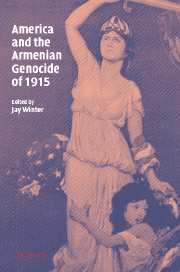Book contents
- Frontmatter
- Contents
- List of contributors
- Map
- Acknowledgments
- Introduction: witness to genocide
- Part 1 The framework
- Part II During the Catastrophe
- 4 A friend in power? Woodrow Wilson and Armenia
- 5 Wilsonian diplomacy and Armenia: the limits of power and ideology
- 6 American diplomatic correspondence in the age of mass murder: the Armenian Genocide in the US archives
- 7 The Armenian Genocide and American missionary relief efforts
- 8 Mary Louise Graffam: witness to genocide
- 9 From Ezra Pound to Theodore Roosevelt: American intellectual and cultural responses to the Armenian Genocide
- Part III After the Catastrophe
- Index
- Studies in the Social and Cultural History of Modern Warfare
7 - The Armenian Genocide and American missionary relief efforts
Published online by Cambridge University Press: 04 September 2009
- Frontmatter
- Contents
- List of contributors
- Map
- Acknowledgments
- Introduction: witness to genocide
- Part 1 The framework
- Part II During the Catastrophe
- 4 A friend in power? Woodrow Wilson and Armenia
- 5 Wilsonian diplomacy and Armenia: the limits of power and ideology
- 6 American diplomatic correspondence in the age of mass murder: the Armenian Genocide in the US archives
- 7 The Armenian Genocide and American missionary relief efforts
- 8 Mary Louise Graffam: witness to genocide
- 9 From Ezra Pound to Theodore Roosevelt: American intellectual and cultural responses to the Armenian Genocide
- Part III After the Catastrophe
- Index
- Studies in the Social and Cultural History of Modern Warfare
Summary
In 1920, an American peace negotiator declared that it was “no exaggeration to say that the Armenians would have disappeared as a nation” had it not been for the relief efforts initiated by the American missionaries. From 1915 to 1927, they were swept into the violence of revolution, war, and annihilation. They saw firsthand the Armenian Genocide and the efforts of the Turkish government to exterminate Turkish Armenians. Numerous missionaries in the field protected countless Armenians and saved their lives, sometimes sacrificing their own. The largest American missionary organization operating in Turkey at that time was the American Board of Commissioners for Foreign Missions, headquartered in Boston. Based on reports it received from its missionaries in the Turkish field, the American Board launched a relief drive that broke new ground in the history of American philanthropy. The American missionaries were the most critical figures in the relationship between the United States and the Armenians during the genocide era. They were unmatched in exerting influence and expertise in the Turkish field and on the American home front, as well as in American policy, intellectual, and cultural circles.
The Protestant missionary movement in the United States derived its fire and zeal from the intellectual and religious atmosphere in early nineteenth-century New England. Impressed with Samuel Hopkins, the prominent Revolutionary War-era religious leader and his doctrine of “disinterested benevolence,” the missionaries followed the call of unabashed devotion to the active service of God.
- Type
- Chapter
- Information
- America and the Armenian Genocide of 1915 , pp. 185 - 213Publisher: Cambridge University PressPrint publication year: 2004
- 2
- Cited by

